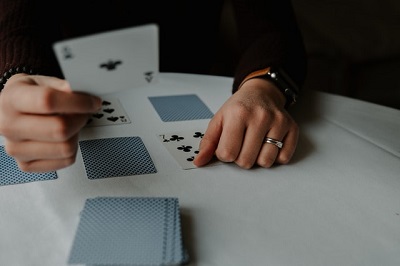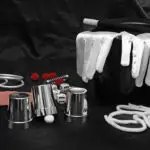
Close-up magic is a type of magic that involves performing tricks and illusions that are done within close proximity of the audience. These tricks often use small objects, such as coins, cards, or other everyday items, and are performed in front of a small group of people or even just one person. (See What is Close-Up Magic?)
In this post, we’ll look at how close-up magic works, techniques the magician uses, and skills that are needed to successfully perform good close-up magic.
How Does Close-Up Magic Work?
The success of close-up magic lies in the ability of the magician to create an illusion that is so convincing that the audience cannot discern how the trick is being done. There are several techniques that magicians use to achieve this effect, including sleight of hand, gimmicks, misdirection, and psychology.
Sleight of Hand
Sleight of hand is a technique that magicians use to manipulate objects in such a way that they appear to vanish or appear out of thin air. This is done through careful manipulation of the object, often with the use of the fingers, palms, or other parts of the hand. The magician will often use a combination of speed, dexterity, and precision to make the trick look seamless and effortless.
One common sleight of hand technique used in close-up magic is known as the palm. This involves hiding an object in the palm of the hand and then making it appear as if the object has vanished or appeared out of nowhere. Another technique is known as the pass, where the magician secretly cuts the deck or controls a card to get it into a certain position, or under the magician’s control in order to perform some impossible looking effect.
Props and Gimmicks
Close-up magicians are experts at entertaining and mystifying their audiences with their sleight of hand and mind-bending tricks. But they often use a variety of props and gimmicks to create illusions and enhance their performance.
One common prop that close-up magicians use is a deck of cards. They may also use trick cards that have been specially designed to allow them to perform certain moves or tricks.
Another popular prop used by close-up magicians is coins. Magicians may use specially made coins that are magnetic, or have mismatching sides, allowing them to perform amazing feats of sleight of hand.
They may also use everyday objects, such as rubber bands, paperclips, or even borrowed items like rings or watches, to create illusions and astonish their audiences.
Some close-up magicians also use other gimmicked devices, such as a thumb tip, a shell coin, or a special pen. These props allow the magician to perform seemingly impossible effects, such as making objects disappear or appear out of nowhere.
Of course, close-up magicians also rely heavily on their own skill and technique to create the illusion of magic, called sleight of hand, as was mentioned earlier. They spend countless hours practicing their moves and perfecting their timing to ensure that their tricks are executed flawlessly.
In addition to their props and gimmicks, close-up magicians also use a variety of misdirection techniques to distract their audiences and make their illusions even more convincing.
Misdirection
Misdirection is another key technique used in close-up magic. This involves drawing the audience’s attention away from the action that is actually taking place. For example, the magician might use a distracting gesture, a verbal command, or a sudden movement to take the audience’s focus away from where the trick is actually being performed.
By directing the audience’s attention to one thing while secretly manipulating another, they are able to create the illusion of true magic.
Psychology
In addition to sleight of hand and misdirection, close-up magic also relies on psychology to create the illusion of magic. Magicians use a variety of psychological techniques to influence the audience’s perception of the trick and create a sense of wonder and amazement.
One such technique is known as suggestion. This involves planting a suggestion in the audience’s mind that influences their perception of what they are seeing. For example, a magician might suggest that a coin is going to vanish, and the audience will then be primed to see the coin disappear, even if it hasn’t.
Another technique is known as the power of expectation. This involves creating an expectation in the audience’s mind of what they are going to see, and then subverting that expectation. For example, a magician might ask the audience to choose a card from a deck, and then reveal the wrong card. However, the magician will then go on to reveal that the wrong card was actually the right card all along, creating a sense of surprise and wonder.
Practice & Skills Needed for Close-Up Magic
Close-up magic requires a great deal of skill, practice, and dedication to master. Magicians spend years honing their craft, perfecting their sleight of hand, misdirection, and psychological techniques to create a seamless and convincing performance. (See also The Best Close-Up Magicians of All Time)
Sleight of hand alone involved in close-up magic tricks can take years to develop. This is not only because the moves must be learned and developed, but they also must be perfected. This is because many sleight-of-hand moves if not practiced enough, will look sloppy, and will easily give away the secret.
One important aspect of practicing close-up magic is also mastering the art of deception. This involves learning how to control the audience’s perception of what they are seeing, and manipulating their expectations to create the illusion of magic.
Another key aspect of practicing close-up magic is developing a strong stage presence. This involves learning how to engage with the audience, build rapport, and create a sense of excitement and anticipation around the performance. Magicians often rely on humor, storytelling, and other performance techniques to keep the audience engaged and entertained throughout the performance.
It’s also important for magicians to have a deep understanding of the tricks and illusions they are performing. This involves not only mastering the physical techniques of the trick but also understanding the underlying psychological principles and mechanisms that make the illusion work. This knowledge allows magicians to adapt their performance to different audiences and situations, and to create new and innovative illusions that continue to amaze and delight their audiences.
In addition to practice and preparation, close-up magic also requires a great deal of creativity and innovation. Magicians must constantly come up with new and innovative ways to perform classic tricks and illusions, as well as develop new illusions that challenge and captivate their audiences. This creativity and innovation allow magicians to stay relevant and exciting in a field that is constantly evolving and changing.
Final Thoughts
Close-up magic is a fascinating and complex art form that requires a unique combination of skill, practice, creativity, and psychology. Magicians use a variety of techniques, including sleight of hand, misdirection, and psychology, to create the illusion of magic and captivate their audiences.
Through years of practice and preparation, magicians are able to master these techniques and create performances that are both entertaining and awe-inspiring. Whether performed for a small group or a large audience, close-up magic is a truly magical and unforgettable experience that continues to captivate and amaze audiences around the world.
The magician started magic as a kid and has learned from some of the greats. He loves to share his knowledge with others and help out with the subtleties he’s learned along the way.
Follow on YouTube at the link below to get free tricks and advice!

